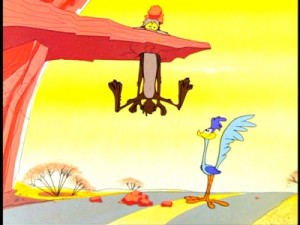Contents: One Acme Poem-Making Kit
In his book Maps of the Imagination: Writer as Cartographer, Peter Turchi discusses the biography of the animator and cartoonist Chuck Jones, creator of the Looney Tunes characters Wile E. Coyote and Road Runner (among others).

Turchi writes that “In his biography, Jones identifies some of the constraints he gave himself for that one series (he made many others),” then lists them as follows:
Rule 1: The Road Runner cannot harm the coyote except by going “beep-beep!”
Rule 2: No outside force can harm the coyote – only his own ineptitude or the failure of the Acme products.
Rule 3: The coyote could stop anytime – if he were not a fanatic (Repeat: “A fanatic is one who doubles his effort when he has forgotten his aim.” – George Santayana)
Rule 4: No dialogue ever, except “beep-beep!”
Rule 5: The road runner must stay on the road – otherwise, logically, he would not be called road runner.
Rule 6: All action must be confined to the natural environment of the two characters – the Southwest American desert.
Rule 7: All materials, tools, weapons, or mechanical conveniences must be obtained from the Acme Corporation.
Rule 8: Whenever possible, make gravity the coyote’s greatest enemy.
Rule 9: The coyote is always more humiliated than harmed by his failures.
Turchi adds that, “Some viewers might be tempted to think of the results as a visual equivalent of pulp romance novels, working the same material in essentially the same ways, with barely discernible and inconsequential variation. But those cartoons’ constraints were dictated not by sales departments, marketing surveys, or audience polls; they were self-imposed by the artist. For all their looniness, Road Runner cartoons are not so far removed from the experimental formalism of the Oulipo.”
So I will put it to my fellow poets: how do you use restrictions in your work and why? Do you think these restrictions, if they were dictated by someone other than you—Turchi’s sales departments or audience polls, for instance—would force you to make lesser work? Turchi is critical of restrictions that are based on marketing, essentially, but a further distinction could also be drawn between restrictions that are traditional (the sonnet form and so forth) and restrictions that are more arbitrary and/or inventive (like those of the Oulipo). Jones’s list suggests elements of both arbitrary inventiveness (“beep-beep!”) and tradition (an insistence on strict adherence to Aristotelian unities). Is one type of constraint more useful than another? Why or why not?
Kathleen Rooney is a founding editor of Rose Metal Press, a publisher of literary work in hybrid genres...
Read Full Biography

